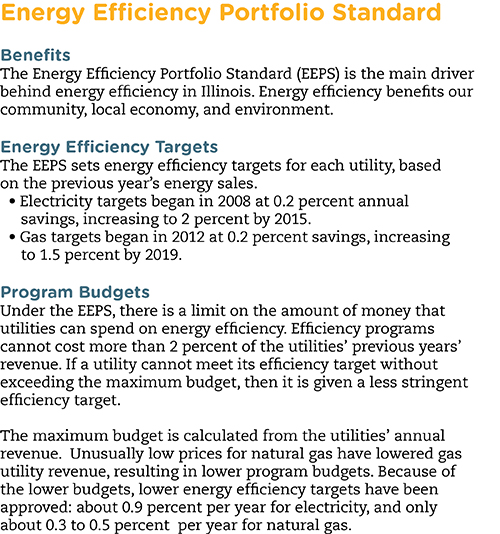Don’t Forget the Furnace and the Boiler: Improving Natural Gas Efficiency in Illinois
This post is written by Marcella Bondie Keenan, policy fellow at Elevate Energy.
Under current Illinois law, utility companies offer rebates for natural gas and electricity efficiency projects. While this is a key driver for improving energy efficiency in Illinois, there is a mismatch in funding between natural gas and electric programs. Natural gas efficiency programs are not as well funded as electricity programs, and this has an adverse impact on multifamily buildings and affordable housing. We see three solutions that will lead to more effective efficiency programs.
A Comprehensive Approach to Energy Efficiency

Elevate Energy’s building services program takes a comprehensive approach to energy efficiency, meaning that we consider the building shell as well as systems that run on either natural gas or electricity. By seeking optimal performance from all systems within a building, we achieve deeper energy savings and lower utility bills and create healthier, more comfortable homes and businesses.
Other programmatic benefits of a comprehensive approach include:
- Enhanced customer service through more robust efficiency choices, customized improvements, and assistance with hard-to-finance items like boiler replacements.
- More accurate energy savings projections.
- Optimized improvements that consider interactions between building systems.
- Reduced program marketing costs – building owners only need to be reached once.
- Reduced transaction fees – building owners can finance all upgrades at once.
We’re able to offer comprehensive services in part because of financing options like utility rebates. Illinois’ Energy Efficiency Portfolio Standard (EEPS) sets energy savings targets for the state and requires utilities to fund energy efficiency programs through a small charge on utility bills. The EEPS has dramatically improved energy efficiency in homes, businesses, and government buildings. (See sidebar for more.)
Mismatch in Natural Gas and Electricity Efficiency Dollars
Unfortunately, there is unequal funding for natural gas and electricity efficiency programs. Natural gas efficiency programs are not as well funded as electricity efficiency programs. This mismatch makes it difficult to implement comprehensive energy efficiency improvements. In addition, less effective and underfunded efficiency programs hit hardest on multifamily buildings and affordable housing.
There are three main reasons for the mismatch in dollars:
- The natural gas EEPS sets lower efficiency targets for natural gas as compared to electricity EEPS efficiency targets.
- The total value of natural gas sales is lower, due to low natural gas prices.
- The natural gas EEPS was enacted more recently than the electricity EEPS so it is further behind in the annual increase to the efficiency target.
Because the natural gas budget lags behind, it is very challenging for utilities to fund comprehensive energy efficiency programs. Although natural gas and electric utilities can collaborate to offer comprehensive programs, they are severely limited by the natural gas funding shortfall.
Electric utilities are responsible for meeting higher efficiency targets, but they can’t reach their goals for joint programs if they are constrained by the size of the natural gas efficiency budget. Electric utilities could potentially perform comprehensive programs on their own, but they aren’t allowed to receive credit toward their efficiency targets through funding natural gas efficiency projects.
Adverse Impact on Multifamily Buildings and Affordable Housing
The mismatch between natural gas and electricity efficiency dollars is a significant problem in our cold climate. In Illinois, space heating makes up more than half of household energy use, and more than 80 percent of households use natural gas as their heating fuel, according to data from the U.S. Energy Information Administration. Because our region’s homes rely so much on natural gas, well-funded gas efficiency programs are necessary to capture the full potential of energy efficiency programs.
When efficiency dollars are low, multifamily buildings and low-income households bear the brunt of the problem. Studies show that, nationwide, multifamily buildings use less energy efficiency measures than other kinds of housing and that lower income renters live in less energy efficient apartments than higher income renters. Low-income households spend a higher percentage of their budget on utility bills. These households also have less ability to pay out of pocket for energy efficiency improvements, even if the improvements save money over time. Funding and rebates for comprehensive, whole-building upgrades will help building owners and low-income households take advantage of the benefits of energy efficiency.
Solutions for Effective Efficiency Programs
Fortunately, there are promising solutions for balancing natural gas and electricity efficiency budgets.
- Alter the EEPS to increase the natural gas program budget and allow for joint delivery of efficiency programs. Coordinate rebates for individual electricity and natural gas programs when there is no formal joint delivery program.
- Allow electric utilities to count natural gas savings towards their efficiency target when they fund gas efficiency measures as part of cost-effective comprehensive improvements.
- Similarly, allow natural gas utilities to count electricity savings towards their efficiency target when they fund electricity efficiency measures as part of cost-effective comprehensive improvements.
By focusing efficiency dollars where they can be most effective – on comprehensive, whole building improvements – deeper energy savings can be achieved. These strategies will help utilities meet annual efficiency targets while targeting hard-to-reach market sectors.
Additional Resources
- ACEEE, Energy Efficiency and Economic Opportunity Fact Sheet
- ACEEE State and Local Policy Database: Illinois
- Database of State Incentives for Renewables & Efficiency: Illinois
- Elevate Energy, Preserving Affordable Housing through Energy Efficiency
- Elevate Energy, Engaging as Partners in Energy Efficiency: A Primer for Utilities on the Energy Efficiency Needs of Multifamily Buildings and their Owners
- Joint Center for Housing Studies of Harvard University, America’s Rental Housing: Evolving Markets and Needs
- Energy Efficiency and its Relationship to Household Income in Multifamily Rental Housing



